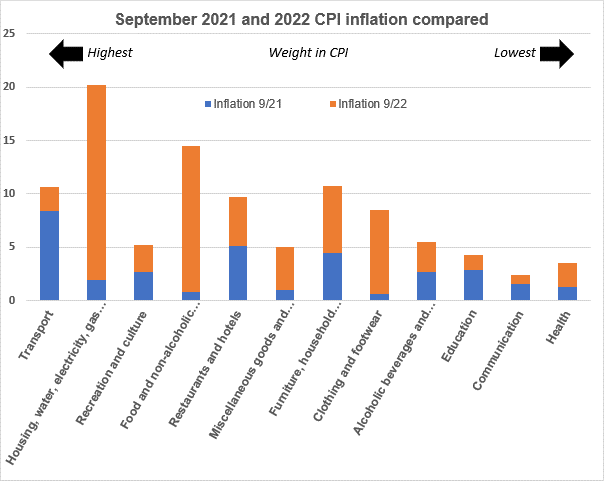NEW Guides & Publications17 Oct 2024
Alliotts Focus – Winter 2024
In this edition of Alliotts Focus we look at; Self-assessment registration, landlord legislation changes, dividend taxation, and voluntary business liquidations
Articles
Annual CPI inflation hit 10.1% in September

Annual CPI inflation hit 10.1% in September, but that does not mean every price is showing a double-digit increase.

Source: ONS
The September Consumer Prices Index (CPI) inflation reading is probably the most important inflation metric in a given year. Traditionally, this number is the one used by the Government as the basis for increasing tax allowances and bands, as well as benefits – including the state pension.
In recent years the significance of September’s CPI reading has waned, as the Government has chosen to freeze or restrict increases to limit the cost to the Exchequer of these benefits. The most obvious recent example is the freeze to the personal allowance (£12,570) and higher rate threshold (£50,270 outside Scotland), which would be £14,270 and £57,170 from April 2023 had the first two years of a four-year freeze not happened.
This year, the September 2022 annual inflation rate of 10.1% is more significant and not all it seems. The graph above shows the annual inflation rate in the 12 categories that make up the CPI ‘shopping basket’ of goods and services.
Variable effects
Only a third of those categories registered inflation above 10%. And another third recorded rises of no more than 5%. All the categories experienced higher inflation in September 2022 than September 2021, when the annual inflation rate was a more modest 3.0%, but the changes brought about over the intervening twelve months have had significantly varied effects across the different categories:
These large variations help explain why your experience of inflation may seem, at different times, better or worse than the headline figure.
The Office for National Statistics (ONS) recognises this fact and has recently introduced an online personal inflation calculator which is worth exploring.
More & Other Musings
View all related contentNEW Guides & Publications17 Oct 2024
In this edition of Alliotts Focus we look at; Self-assessment registration, landlord legislation changes, dividend taxation, and voluntary business liquidations
NEW Articles17 Oct 2024
Finance for independent films in the UK has received a huge boost courtesy of the new enhanced Audio Visual Expenditure Credit (AVEC) known as Independent Film Tax Credit (IFTC)
NEW Articles16 Oct 2024
Tax rises are a dead cert, we all know that, but what else can we look forward to?
NEW Articles11 Oct 2024
Rental property has been set a government target to meet an energy performance certificate (EPC) rating of C by 2030. Although new funding in support of this initiative has been announced, the grants will not help all landlords.
NEW Articles11 Oct 2024
With a ‘black hole’ of £22 billion to fill, there are plenty of groups giving Rachel Reeves advice.